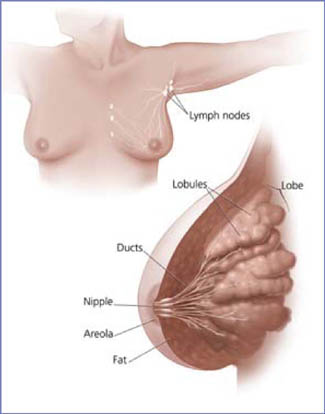|
About Your Breasts
Breast Basics
The breast is a
gland
that produces milk in late pregnancy and after childbirth.

What are breasts made of?
- Each breast is made of
lobes.
- Lobes are groups of milk glands called
lobules.
- Lobules are arranged around thin tubes called
ducts.
- Ducts carry the milk to the nipple.
- These lobules and ducts make up the
glandular tissue.
What is the lymphatic system?
The breasts also contain
lymph vessels, which carry a clear fluid called
lymph.
- The lymph vessels lead to small, round organs called
lymph nodes.
Groups of lymph nodes are found near the breast in the underarm, above the collarbone, in the chest behind the breastbone, and in many other parts of the body.
- The lymph nodes trap bacteria, cancer cells, or other harmful substances that may be in the
lymphatic system. Their job is to make sure harmful substances are safely removed from the body.
| See your health care provider about a breast change when you have:
|
- A lump in or near your breast or under your arm
- Thick or firm tissue in or near your breast or under your arm
- Nipple discharge or tenderness
- A nipple pulled back (inverted) into the breast
- Itching or skin changes such as redness, scales, dimples, or puckers
- A change in breast size or shape
If you notice a lump in one breast, check the other breast. If both breasts feel the same, it may be normal.
You should still see your health care provider for a
clinical breast exam
to see if more tests are needed.
|
 Back to Top Back to Top
Next Section > |